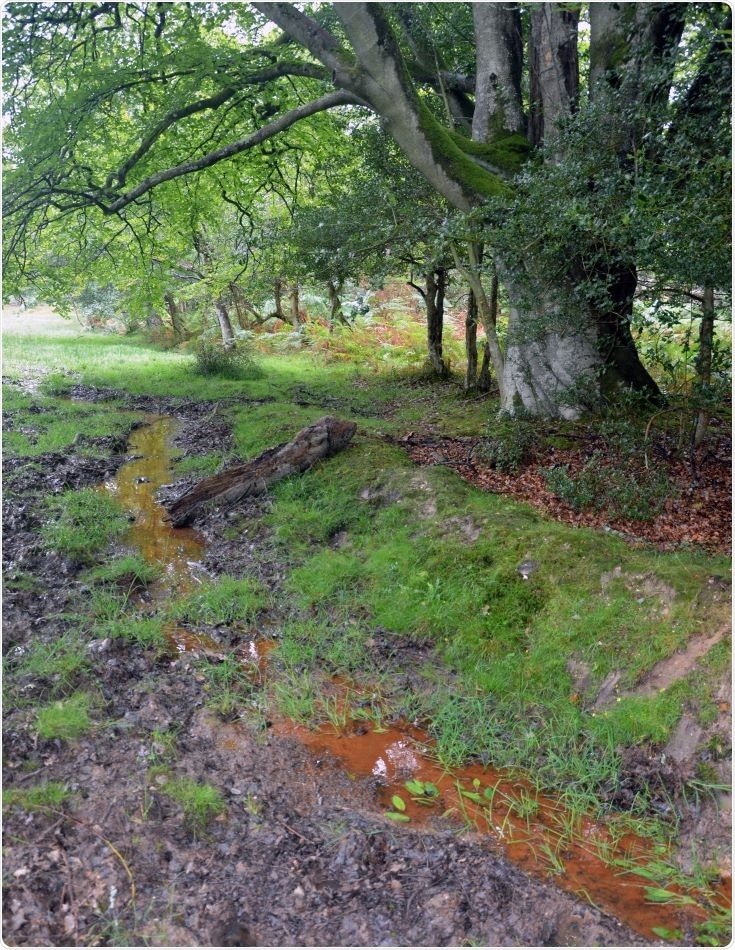Hydrological fluctuation can significantly influence and alter the functions of water-dominated ecosystems. The changing states of redox-active substances are highly significant in this case.

Leakage of iron-rich groundwater in a cattle pasture. The red color comes from a mixture of oxidized iron and carbon compounds, which are highly reactive redox phases. Image Credit: Stefan Peiffer.
Scientists from the University of Bayreuth have now identified this significance, in association with collaborators from the University of Tübingen, the University of Bristol, and the Helmholtz Centre for Environmental Research, Halle-Leipzig. The researchers have presented their findings in the Nature Geoscience journal.
The latest research work allows a more accurate interpretation of the biogeochemical processes that play a key role in the degradation of pollutants and the mitigation of greenhouse gas emissions.
Storing carbon, decreasing the emission of greenhouse gases, offering high-quality drinking water, and removing environmental pollutants, like nitrate, are all crucial services rendered by aquatic ecosystems, including marshes, bogs, streams, and lakes.
The functions of these aquatic ecosystems are closely associated with the cycles of carbon, nitrogen, oxygen, and other natural elements. Historically, elemental cycles have been known to be interconnected biogeochemical processes that can be considerably affected by hydrological fluctuations. Changes in the water level of groundwater, peatlands, and wetlands, or even varying flow directions in groundwater are some of the examples of hydrological fluctuations.
Researchers headed by Professor Dr. Stefan Peiffer from the University of Bayreuth have now gained a more accurate understanding of the reliance of element cycles on a hydrological fluctuation. As demonstrated by various laboratory analyses, redox-active substances play a crucial role in this.
Anyone who has ever trudged through a swamp or rummaged in the sand of a swimming lake will have noticed these substances because of their variety of colour. In a very confined space, colour shades alternate from deep black to grey and brown to light red. What is behind this, is an interplay of microbiological and chemical processes in which electrons are being transferred. In research, we call them redox reactions.”
Dr Stefan Peiffer, Professor, University of Bayreuth
Respiration in animals and humans is a relatively basic form of redox reaction. Carbon dioxide is formed by the oxidization of carbon. In the microbially driven redox reactions that occur in a swamp, for instance, the function of oxygen is taken over by a wide range of redox-active substances, like humic substances or manganese, sulfur, and iron compounds.
While these substances have an extremely short life span, they display a highly powerful tendency to take part in redox reactions; hence, they are referred to as “redox-active metastable phases” or RAMPs for short. Because of their high reactivity, RAMPs have a crucial role to play in elemental cycles in ecosystems. For instance, RAMPs are capable of degrading pollutants, like nitrates or many other organic chemicals.
The continuous change between the electron-donating condition and the electron-accepting condition is one of the reasons for the brief lifespan of RAMPs. Published in the Nature Geoscience journal, the research work reaches a conclusion critical for environmental and ecological studies.
The dynamics of the redox reactivity of RAMPs are activated by hydrological changes that take place in rice-growing soils, waterlogged soils, wetlands, shore zones, or at the surface of sediments in rivers and lakes.
Such small-scale biogeochemical reactions, consequently, affect the massive reactions of the ecosystem, for instance, the proportion of greenhouse gases emitted into the air. For the first time, this makes it comprehensible how hydrological changes, for instance, the changing water levels, have an impact on elemental cycles in nature, and thus the working of ecosystems.
Our study shows that biogeochemical reactions on a scale of only a few micrometres form an important crux between two large-scale processes: between hydrological fluctuations on the one hand, and ecosystem functions on the other.”
Dr Stefan Peiffer, Professor, University of Bayreuth
“Our new findings will therefore help to better predict pollutant degradation in aquatic ecosystems in the future. The consequences of climate change for carbon and nitrogen conversion in these ecosystems may also be more accurately assessed in the future,” concluded Dr. Peiffer.
Source:
Journal reference:
Peiffer, S., et al. (2021) A biogeochemical-hydrological framework for the role of redox-active compounds in aquatic systems. Nature Geoscience. doi.org/10.1038/s41561-021-00742-z.